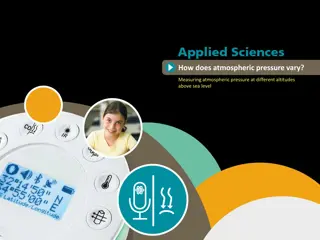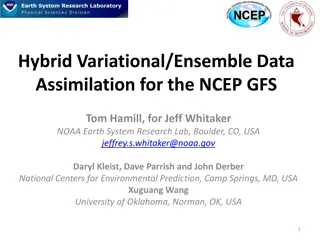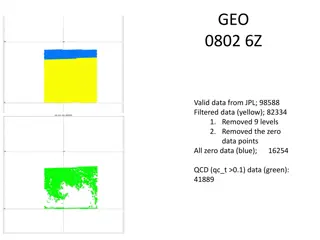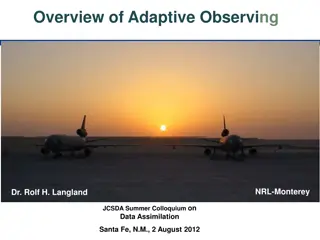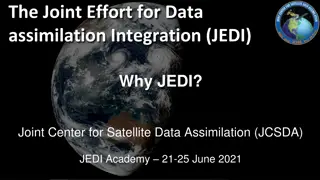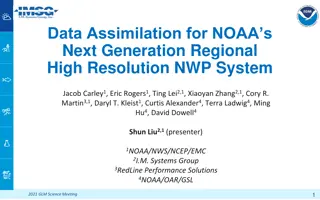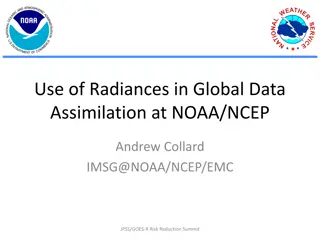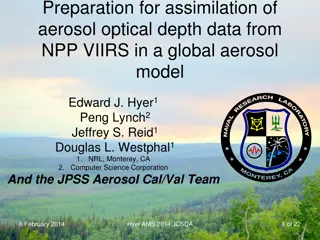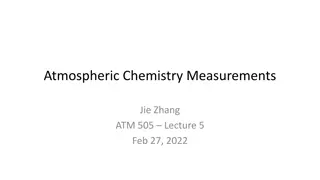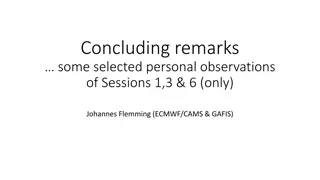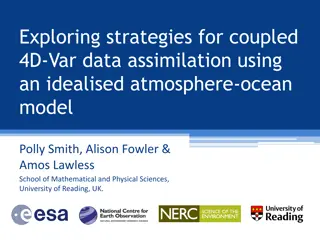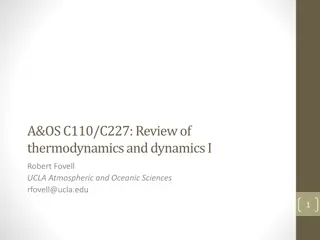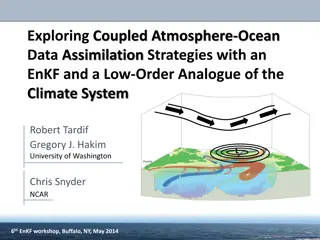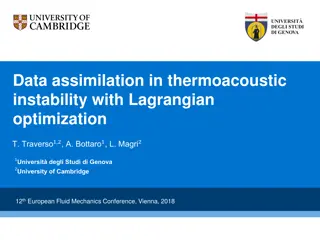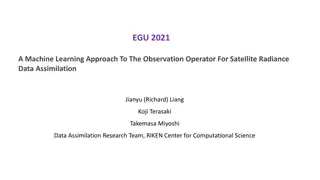Insights on Data Assimilation and Evaluation in Atmospheric Research
This material delves into the pivotal areas of data assimilation and evaluation in atmospheric research, focusing on topics such as multi-scale refinement, meteorology, chemistry synergies, emissions, extreme events, and strategic partnerships. It highlights the significance of effective multi-scale data assimilation, challenges faced in the process, and the need for strategic collaborations to enhance research outcomes.
Download Presentation

Please find below an Image/Link to download the presentation.
The content on the website is provided AS IS for your information and personal use only. It may not be sold, licensed, or shared on other websites without obtaining consent from the author.If you encounter any issues during the download, it is possible that the publisher has removed the file from their server.
You are allowed to download the files provided on this website for personal or commercial use, subject to the condition that they are used lawfully. All files are the property of their respective owners.
The content on the website is provided AS IS for your information and personal use only. It may not be sold, licensed, or shared on other websites without obtaining consent from the author.
E N D
Presentation Transcript
Working Group DA and evaluation This material is based upon work supported by the National Center for Atmospheric Research, which is a major facility sponsored by the National Science Foundation under Cooperative Agreement No. 1852977.
Summary New science: Strong support for the Regional refinement multi-scale, including down to urban and convection scale DA for 2-way cross constraints Meteorology and Chemistry Synergies AQ/GHG, emissions versus background, seamless global to local scales Emissions (multi-scale coupled DA, anthropogenic versus natural/biogenic, unobserved VOC species), developing world Extreme events (e.g. dust storm, fires) Seasonal scale forecasting Effective multiscale DA, in space and time Obstacles and challenges: Think about a strategy, since DA is usually done for a fixed grid Fit with the modeling infrastructure, adjoint development, multi physic ensemble, needs to be thought from the start Evaluation: postprocessing and verification package, address storage/IO, subsets for observations and statistics versus everything Different interests for different users Strategic partnerships JEDI, ECMWF, EPA and Air Quality agencies around the world, Space agencies for access to satellite measurements with minimum data latency, IGAC (AMIGO, GEIA, MAP-AQ) Data Assimilation Working group, verification should be cross cutting
Questions posed to the Breakout Groups: 1. Which working group(s) for MUSICA do you see evolving from your topics? 2. What are the scale-dependencies of your topic considering the range of applications from urban air quality to upper atmospheric research and timescales from days to centuries? 3. What are or could be the major obstacles to the proposed development plan for MUSICA? 4. Does the proposed realization of MUSICA address your research needs? 5. What new science can be addressed with the new modeling infrastructure? 6. What next major development steps for MUSICA are necessary to consider the processes in your topic? 7. What type of diagnostics should be part of the output? 8. Are there dependencies between your and other working groups to be considered? 9. What multi-lateral Strategic Partnerships should be established and what specific Deliverables will they include? Please assign a rapporteur to report the group s response to the above points. Atmospheric Chemistry Observations and Modeling Laboratory
Which working group(s) for MUSICA do you see evolving from the topic? Answer: DA/IM working group Serve the other working groups or having a Link with numerical/software engineer group, adjoint
What are the scale-dependencies considering the range of applications from urban air quality to upper atmospheric research and timescales from days to centuries? Answer: Down to convection scale, urban scale
What are or could be the major obstacles to the proposed development plan for MUSICA? Answer: Think about Variational methods, choice of DA framework Object-oriented algorithm (OOPS) Fits with JEDI ?
Does the proposed realization of MUSICA address your research needs? Answer: Yes MUSICA will provide new opportunities by providing connection between scales in a unified and consistent framework
What new science can be addressed with the new modeling infrastructure? Meteorology-chemistry interactions New project using DART, improving NOx emissions using NO2 from Geo, in order to improve wind, soil moisture, Boundary layer mixing Improve AQ forecasting over Dehli, aerosols and fog, accounting for aerosol-meteorology feedback Long range transport at continental scale Effective multiscale DA? think about a strategy, since DA is usually done for a fixed grid DA for long lived Greenhouse Gases, reconciling the scales from emissions at city scale (Indianapolis field experiments, San Fransisco) and large scale, having NOAA, TROPOMI at larger scale and GEO at continental scale Synergies AQ/GHG at urban scale component, proxy for emissions NO2; ethane; VOC emissions, using ensemble to force unobserved species Connection with the biosphere, in a Extreme events (e.g. dust storm) Consideration about transport and meteorology at smaller spatial scale, large scale to smaller scale interaction in dynamic, ensemble approach. Fit with the modeling infrastructure, adjoint development, multi physic ensemble, needs to be thought from the start Evaluation of emissions: impact of the emission re-gridding from totals, in particular in countries where proxies are not defined (Africa, South America) Seasonal scale forecasting
What new science can be addressed with the new modeling infrastructure? Evaluation Evaluation of emissions: impact of the emission re-gridding from totals, in particular in countries where proxies are not defined (Africa, South America) Tools for postprocessing and verification, diagnostics packages, open source, user friendly and practical comes with the model Templates for outputting, facilitates inter model comparison (AEROCOM, MIP experiments) Comparison to analyzed fields Save observation operator to compare at higher temporal resolution, along aircraft tracks, surface monitoring sites, higher temporal scale Consider saving high temporal resolution (surface values) Take into account spatial (horizontal and vertical) and temporal representativeness at different scale, background to urban scale (weekend effects proxy), modes of variability Observation types remote to traffic/industrial, including observation error for DA Surface sublayer for human health impact assessment, points to vertical mixing
What next major development steps for MUSICA are necessary to consider the processes in your topic? Answer: Make sure DA at different spatial and temporal scales, build upon existing NCAR and Agencies and community capabilities
What type of diagnostics should be part of the output? Answer: Observation operators have to be made available from the DA side to the model diagnostic package to facilitate model/satellite comparison Different interests for different users Regridded output package available (fluxes)
Are there dependencies between your and other working groups to be considered? Answer: Yes
What multi-lateral Strategic Partnerships should be established and what specific Deliverables will they include? Answer: JEDI ECMWF Air Quality agencies, connections to EPA (emission inventories post processing tools, observations) and around the world (access to measurements) Space agencies for access to satellite measurements with minimum data latency IGAC AMIGO, GEIA, MAP-AQ



